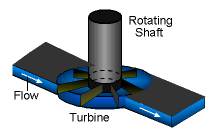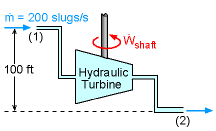| Ch 4. Fundamental Laws (Integral Anal.) | Multimedia Engineering Fluids | ||||||
|
Conservation Mass |
Linear Momentum |
Moment of Momentum |
Conservation Energy |
||||
| Conservation of Energy | Case Intro | Theory | Case Solution |
| Chapter |
| 1. Basics |
| 2. Fluid Statics |
| 3. Kinematics |
| 4. Laws (Integral) |
| 5. Laws (Diff.) |
| 6. Modeling/Similitude |
| 7. Inviscid |
| 8. Viscous |
| 9. External Flow |
| 10. Open-Channel |
| Appendix |
| Basic Math |
| Units |
| Basic Fluid Eqs |
| Water/Air Tables |
| Sections |
| eBooks |
| Dynamics |
| Fluids |
| Math |
| Mechanics |
| Statics |
| Thermodynamics |
| ©Kurt Gramoll |
|
|
||
| Introduction |
||
|
|
Hydroelectric power is the largest source of renewable energy produced in the United States. As water flows through turbines, mechanical energy in terms of shaft work is produced, and electricity is generated by converting this mechanical energy through generators. Consider a turbine with the inlet and outlet conditions as shown in the figure. The water flows at a rate of 200 slugs/s. The pressure drop is 50 psi across the 100 ft elevation difference between the inlet and outlet. The inlet and outlet pipe radii are 2 ft and 3 ft, respectively. How much power will the hydraulic turbine produce? | |
| Questions |
||
Determine the rate of work done (power) produced by the turbine. |
||
| Approach |
||
|
||
Practice Homework and Test problems now available in the 'Eng Fluids' mobile app
Includes over 250 free problems with complete detailed solutions.
Available at the Google Play Store and Apple App Store.


